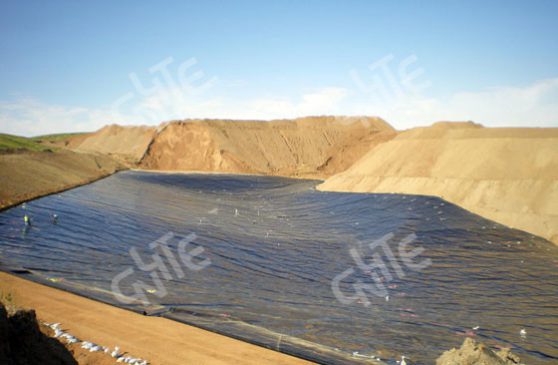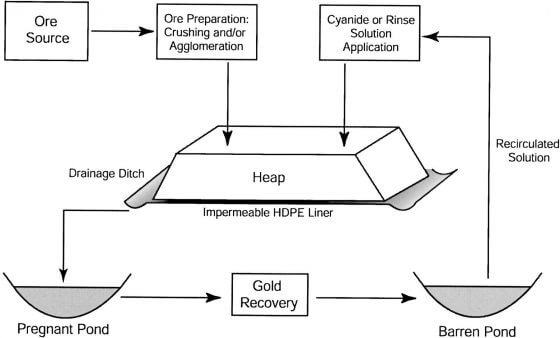
2019-10-12 Views:7647
Warm Tip: If you want to know more information, like quotation, products, solutions, etc., please Click here ,and contact us online.

Heap leaching is a method in which a leaching solution is sprayed with a spray leaching system to selectively leach the useful minerals in the ore and recover the useful mineral from the pregnant liquid flowing out of the heap during the infiltration process. Low-grade gold ore heap leaching is a new gold extraction process developed in the 1980s. It is characterized by simple process, easy operation, short process, small floor space, strong adaptability, large or small scale, and low investment. The production cost is low. The disadvantage of this method is that the leaching rate is lower; generally only 60-80% can be recovered.
The Simple Operation of Gold mine heap leaching is following:
1. To crush low-grade gold mines to a certain particle size (or granulation);
2. Pile them on a leak-proof bottom pad paved with asphalt, concrete or plastic materials, etc;
3. Spray low-concentration cyanide, alkaline solution, non-toxic solvent or sulfuric acid on the heap to dissolve the gold;
4. The gold-containing solution is leached from the heap;
5. To recover gold by adsorption of activated carbon or displacement of zinc powder.

The industrial cyanide heap leaching method can be divided into two types, one is short-term heap leaching and the other is long-term heap leaching.
In the short-term heap leaching method, the ore is usually crushed to less than 20 mm. When processing gold-bearing quartz veins, it is often crushed to less than 6 mm. The crushed ore heap is leached on a permanent bottom mat, with stack height of generally 3-6 meters, per heap processing volume of 100-10000 tons, and per heap leaching cycle of generally 7-30 days. After a cycle of leaching is completed, the waste is removed from the bottom mat, and then a new batch of crushed gravel is piled up for the next cycle of leaching.
During long-term heap leaching method, using open-pit mining of loose and unbroken low-grade ore, which may contain some giant gravel, but most of the feedstock is less than 150 mm, and the capacity is 10,000-2,000,000 tons of ore per heap. The heap is similar to a truncated cone with 6-10-meter height. This heap has a long leaching period of about 4-5 months, which is based on the principle of leaching most of the useful mineral in the heap and may require a leaching period for several years. After the leaching is completed, the waste is piled on the bottom pad.
Conditions that must be met for ore that is suitable for heap leaching:
1. Gold and silver can be leached from ore by oxidation;
2. The particle size of gold must be very fine;
3. The ore must be able to penetrated by the cyanide solution, which means that the ore either have cracks, or can produce cracks by crushing;
4. There is small content of clay in the ore, and its permeability can be improved by pelleting;
5. The ore doesn’t contain carbonaceous material capable of adsorbing gold cyanide complex;
6. Does not contain a large number of compounds that can react with cyanide solution, such as partially oxidized antimony sulfide, zinc sulfide, iron sulfide, copper sulfide and arsenic-containing minerals.
Heap leaching is often used to develop small-sized gold deposits or low-grade ore (1-3 g/t), or those small low-grade gold mines that cannot be developed and utilized by conventional methods.
The heap-leaching field has little requirement in terrain conditions, and can be adapted to local conditions. According to the topographical features, permanent unloading yards or superimposed yards are respectively set up. For example, the top of the mountain and the hillside are slower and wider, thus suitable for a permanent unloading yard.
The heap leaching process to extract gold is as following:
1. Raw Ore Preparation
2. Leaching Mat Construction
3. Ore Stacking
4. Preparation of Leaching Solution
5. Spray and Collect Leaching Solution
6. Pregnant Solution Treatment
This includes crushing, screening or granulation and pretreatment. In order to improve the leachability of the ore and the permeability of the heap, avoid the phenomenon of uneven flow, blockage, channeling, etc., improve the metal recovery rate, reduce the consumption of the solution and improve the leaching effect, the ore must be broken to be suitable for leaching. Those ores containing more clay or mineral powder need to finely crushed to 6mm or less for granulation, that is, after adding a certain amount of water (30-40kg/t) and immersion liquid (25kg/t) in the crushed ore, stirring them in the granulator to bond the clay and the ore powder to the coarse particles and form a granular mineral, which can be used for pile-up after drying. If the content of clay and mineral powder of -0.075mm in the mineral material is high (8% to 10%), it is necessary to add a binder. The commonly used binders are cement (2~4kg/t) or lime (1.5~5kg/t). Sometimes in the granulation process, the leaching solution is added to pretreat the ore. The purpose of granulation and pretreatment is mainly to improve the permeability of the leaching dump and the leaching rate of the useful mineral.
In order to collect the pregnant solution and prevent the solution from leaking, the heap yard needs to be trimmed and padded (or bottomed) before ore stacking. The materials for the leaching mat construction are clay, sand, gravel, tailings, asphalt, reinforced concrete, plastic film or rubber plastic board, etc. Depending on the material, the thickness of the mat is generally 300-600 mm. The longitudinal and lateral drainage grooves are paved with lump ore on the mat, and a large ore is further laid on the entire bottom to protect the bottom mat.
The purpose of ore stacking is to make the heap have good and uniform permeability and to ensure that the side slope does not collapse. The height of the heap depends mainly on the permeability of the heap, the amount of the leaching agent in the leaching solution, and ore stacking equipment and methods. The height of the gold ore heap is generally 1 to 4 m, and the copper ore and uranium ore heap generally 3 to 30 m. The ore volume of the heap is generally from several hundred tons to several hundred thousand tons, and there are millions of tons of copper-poor heaps. The ore stacking method includes a multi-layer construction method, a multi-stack construction method, a slope pile-up method, and a moving bridge type pile-up method. The pile-up equipment mainly includes scrapers, front-end loaders, dump trucks, bulldozers, belt conveyors and special pilers.
The water and the leaching agent are formulated into a solution for leaching the useful element from the ore, which is also called a working solution. The formulation of the leaching solution and its amount are mainly determined by the mineral, mineral composition and chemical composition. In industrial-scale heap leaching, the available leaching agents are H2SO4, HNO3, HCl, Na2CO3, NaHCO3, (NH4)2CO3, NH4HCO3, Fe2(SO4)3, NaCl, KCl, Nal, Kl, (NH4). 2SO4, air, oxygen, permanganate, nitrogen oxides, hydrogen peroxide and chlorate. In order to accelerate the leaching of sulfide minerals and certain useful element of the oxidized ore, a bacterial liquid is also added to the leaching solution.
Spray the immersion solution evenly on the top surface of the heap. The liquid distribution (spray) system is composed of a liquid mixing tank, a pump, an infusion tube, and a spray pipe and a shower device laid on the heap. Plastic pipes are commonly used as sprinkler pipes, and showers are often swing type. The first requirements for spraying are to spray the leaching solution evenly on the heap. The second is to achieve the required spray intensity, that is, the spray amount per unit area per unit time, usually 0.1 to 0.4L. /m•min. In the heap leaching process, the spraying time accounts for about 1/3 to 1/2 of the total leaching time; in addition to the spray method, there are also other methods such as irrigation and drip irrigation. The liquid collection method of heap leaching is relatively simple, in which the rich liquid from the bottom of the pile is transferred into the sump through the liquid sump, and then pumped to the workshop for processing.
The process technology for recovering metal from rich liquid depends on the mineral types: for extraction of uranium, the common methods are extraction and ion exchange precipitation method and solvent extraction – electrowinning method; while for extraction of gold, common method is activated carbon (or ion exchange resin) adsorption – electrowinning method and displacement precipitation method.
 86 18716000713
86 18716000713
 shirleyyin321@gmail.com
shirleyyin321@gmail.com
 No. 188, Xinhai Street, high-tech Industrial Park, Fushan District, Yantai, Shandong, China.
No. 188, Xinhai Street, high-tech Industrial Park, Fushan District, Yantai, Shandong, China.
